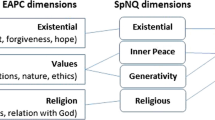Abstract
The current study was designed to identify indicators of spiritual well-being in persons 65 years of age and over, using a grounded theory approach through the constant comparative method of data analysis. The basic social process of harmonious interconnectedness was discovered. This process was the unifying force between categories and within each identified category. The study has implications for health care personnel in that it provides a basis for assessing spiritual well-being in patients.
Similar content being viewed by others
References
Garrett, S., and Garrett, B., “Humaneness and Health,”Topics in Clinical Nursing, 1982,3, 4, 8.
Dunn, H. L., “What High-level Wellness Means,”Health Values: Achieving High-level Wellness, 1977,1, 1, 9.
Highfield, M. F., and Cason, C., “Spiritual Needs of Patients: Are They Recognized?”Cancer Nursing, 1983,6, 187–192.
Fish, S., and Shelly, J. A.,Spiritual Care: The Nurse's Role. Downers Grove, Illinois, Intervarsity Press, 1978, p. 170.
Ibid., p. 9.
Ibid., pp. 147–149.
Ibid., pp. 150–166.
Ibid., p. 10.
Ibid., p. 163.
Ibid., p. 166.
O'Brien, E., “Religious Faith and Adjustment to Long-term Hemodialysis,”J. Religion and Health, 1982,21, 1, 68–80.
Baldree, K. S.; Murphy, S. P.; and Powers, M. J., “Stress Identification and Coping Patterns in Patients on Hemodialysis,”Nursing Research, 1982,31, 2, 109–111.
Miller, J. F.,Coping with Chronic Illness: Overcoming Powerlessness. Philadelphia, F. A. Davis, 1983, p. 27.
Stevenson, J. S., “Load, Power, and Margin in Older Adults,”Geriatric Nursing, 1980,1, 1, 55.
Glaser, B., and Strauss, A.,The Discovery of Grounded Theory: Strategies for Qualitative Research. Chicago, Aldine Publishing, 1967.
Glaser, B.,Theoretical Sensitivity: Advances in the Methodology of Grounded Theory. Mill Valley, Calif., Sociology Press, 1978.
Denzin, N. K.,Sociological Methods. Chicago, Aldine Publishing, 1970, p. 105; Glaser, B.,Theoretical Sensitivity, op. cit, pp. 36–54; Mullen, P. D., and Reynolds, R., “The Potential of Grounded Theory for Health Education Research: Linking Theory and Practice,”Health Education Monograph, 1978,6, 3, 283.
Glaser,op. cit., pp. 93–115.
Author information
Authors and Affiliations
Additional information
This study was partially funded by a special project grant from Marquette University.
Rights and permissions
About this article
Cite this article
Hungelmann, J., Kenkel-Rossi, E., Klassen, L. et al. Spiritual well-being in older adults: Harmonious interconnectedness. J Relig Health 24, 147–153 (1985). https://doi.org/10.1007/BF01532258
Issue Date:
DOI: https://doi.org/10.1007/BF01532258




